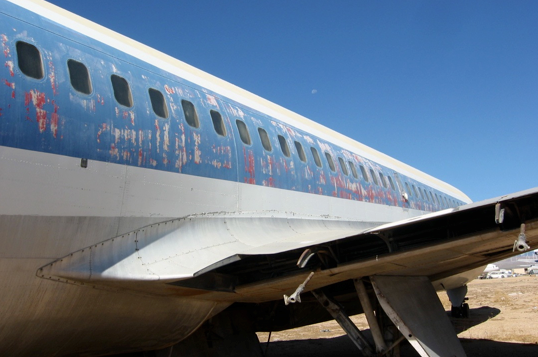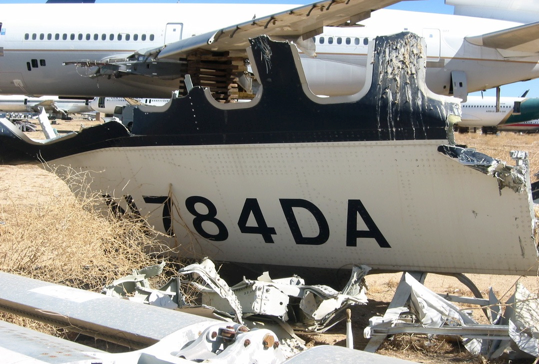LETTER FROM MOJAVE
STORY AND PHOTOS BY PATRICK SMITH

THE WING IS SHORN OFF. It lays upside down in the dirt amidst a cluster of desert bushes. The flaps and slats are ripped away, and a nest of pipes sprouts from the engine attachment pylon like the flailing innards of some immense dead beast. Several yards to the west, the center fuselage has come to rest inverted, the cabin cracked open like an eggshell. Inside, shattered rows of overhead bins are visible through a savage tangle of cables, wires, ducts, and insulation. Seats are flung everywhere in smashed-up units of two and three. I come to a pair of first class chairs, crushed beneath the remains of a thousand-pound bulkhead. In the distance, the plane’s tail sits upright in a gesture of mutilated repose, twisted sharply to one side. High on the fin, the blue and white logo remains visible, save for the vacant portion where the rudder used to be.
Total casualties: zero.
But this is no tale of miracle survival, because where I’m standing isn’t the scene of a catastrophic plane crash at all. Rather, I’m taking in one of the aviation world’s most curious and fascinating places, the “boneyard” at Mojave airport in California, 70 miles north of Los Angeles.
The Mojave Desert is a barren place, a region of forbidding rocky hills and centuries-old Joshua Trees. But it’s also an area with a rich aerospace history. Edwards Air Force Base and the U.S. Navy’s China Lake weapons station are both here, as well as the airport in Palmdale, where the Lockheed L-1011 was built. The Mojave Airport, officially known as the Mojave Airport and Civilian Aerospace Test Center, is the first FAA licensed “spaceport” in the United States, home to a burgeoning commercial spacecraft industry. It’s a spot for ingenuity and innovation, you could say. But for hundreds of commercial jetliners, it is also the end of the road.
Of several aircraft scrapyards and storage facilities, including others in Arizona, Oklahoma, and elsewhere in California, Mojave is arguably the most famous. I say “famous,” but that’s the aero-enthusiast speaking. There aren’t many people who’ll grasp the meaningfulness of what is essentially a blighted desert-scape of derelict and mothballed jetliners, many of them in rather violent stages of disassembly. It’s a hot, ugly, noisy place – a Mad Max vista of rugged brown earth, airliner hulks, and the machinery used to disembowel and break them up. Even for me, the idea of a pilgrimage to this strange place is difficult to understand. Do automobile enthusiasts seek out junkyards, to watch their favorite cars being pulverized into scrap metal? Perhaps they do, but as an aerobuff, peering above my head at the half-dismantled tail of a Continental Airlines DC-10. I feel like a horseracing aficionado at a rendering plant, where his beloved filly is about to be made into glue.

Then again, the Mojave boneyard is the closest thing anywhere to an airliner cemetery – a place of final resting, and for paying final respects to some of civil aviation’s most storied aircraft.
There are upwards of 200 planes currently at Mojave, though the number rises and falls as hulls are destroyed — or returned to service. Not all of the inventory is permanently grounded or slated for destruction. Neither are the planes necessarily old. Aircraft are taken out service for a host of reasons, and age, strictly speaking, isn’t always one of them. The west side of the airport is where most of the newer examples are parked. MD-80s, Fokker 100s, and an assortment of later-model 737s line the sun-baked apron in a state of semi-retirement, waiting for potential buyers. They wear the standard uniform of prolonged storage: liveries blotted out, intakes and sensor probes wrapped and covered to protect from the ravages of climate – and from the thousands of desert jackrabbits who make their homes here. A few of the ships are literally brand new, flown straight directly from the assembly line to await reassignment after a customer changed its plans. For a while, in the capacity downturn that followed September 11th, Mojave brimmed with factory-fresh Boeings and Airbuses deferred here until business picked up or new owners could be found.
Most of the Mojave inventory, however, is one way or another obsolete. Some will make it out of here to again haul passengers and cargo. Many will not. Those in the east side boneyard have, with very few exceptions, flown for the last time. Adjacent to a 40 year-old DC-8 freighter rests a 767 no more than half that age. I pick out the colors of Ansett, a defunct Australian carrier that was one of Boeing’s first customers for the widebody twin in the early 1980s. Like the old Douglas parked next door, the 767 is engine-less, rudderless, and destined for the crusher. The scrap value of a carcass is anywhere from $15,000 to $30,000.
“New arrivals, as it were, tend to come in bunches,” explains Mike Potter, one of several Mojave proprietors. “I’m expecting a dozen or so DC-9s from a Mexican carrier any day now.” Potter and the others, each with his own little parcel of desert, take custody of mothballed aircraft on behalf of the owners, or buy them outright to be scrapped or parted-out. It’s a secretive, tight-knit group. One person I spoke to describes Mojave’s custodians as a sort of desert mafia. The aircraft are off limits without specific permission and their minders are known to charge exorbitant fees for Hollywood crews that frequently use the site for film shoots.
With prior arrangement and a good excuse – I was there with a documentary film crew working for Discovery Channel — Potter will escort you to the boneyard in his pickup. Before heading out, he delivers an overheated sermon on the dangers of skulking around derelict airplanes: jagged metal, loose parts, corrosive fluids, rattlesnakes.
Potter is a retired TWA pilot who, at age 23 according to his own boast, was the world’s youngest captain at a major airline. Potter’s first jet was the Convair 880, a four-engine relic similar in design to the more successful 707 and DC-8. No 880s exist anywhere in flyable condition, but several ancient examples are strewn around Mojave in degrees of disassembly, including one now in the hands of preservationists. Some of these are very same ships piloted by Potter almost five decades ago. He keeps one, which he owns outright, in semi-serviceable, if not exactly flyable condition (it has, among other handicaps, no engines). “We periodically apply electrical power,” he says, “to keep the lights and gauges working.” The red side-stripe has been bleached sky blue, but the faded profile of TWA’s twin globe trademark still adorns the tail.

The logo is in slightly better condition than the one on the hat that Potter wears around the field – a toy captain’s cap with a brim encrusted with plastic rhinestones. Potter is, let’s just say, a large fellow, with a waterfall white beard and a way of speaking that is both engaging and hotly irascible. He’s got the looks of Karl Marx, the raffish drawl of Yeager, and a touch of charismatic nuttiness.
Potter seems professionally detached from the machines he so obviously loves, but yet, according to the rules of his job, must occasionally destroy. Motioning toward a sun-bleached row of planes, there’s a sad seriousness in his eyes – like a marine biologist encountering a pod of stranded whales on a beach.
Before they’re broken up, jets are scavenged for any useful or valuable parts. Control surfaces – ailerons, rudders, slats and elevators – have been carefully removed. Radomes — the nose-cone assemblies that conceal a plane’s radar — are another item noticeable by their absence. And, almost without exception, engines have been carted away for use elsewhere, in whole or in part. Potter has a point about being careful out here, for the boneyard floor is an obstacle course of random, twisted, dangerously sharp detritus.

Curiously, I notice hundreds discarded oxygen masks, their plastic face cups bearing the gnaw marks of jackrabbits. Some of the jets are almost fully skeletonized, and much of what used to rest inside is now scattered across the ground.
Which, for those of us prone to philosophize over such things, brings up an interesting point: When is an airplane no longer an airplane? Consider what’s left of this Douglas DC-8:
Those blue stripes identify the former owner, Eastern Airlines. Eastern took delivery of this plane in February, 1960 (six years before I was born), then disposed of it 13 years later. It has been roasting at Mojave ever since, growing smaller and smaller to the point where it’s really not a plane at all. (Peeking into the chopped-off cabin, I’m struck to discover 60s-vintage seats and the original, rack-style overhead bins securely in place.) The registration code, N8604, survives on the side. Like a piece of DNA, this code can be used to trace the jet’s lineage. An aircraft registration, like a car’s license plate, often changes over time, but by cross-referencing with the construction number, it’s possible to trace a detailed, and sometimes remarkable history.
Near the eastern perimeter sits a mostly intact Continental Airlines 747. This is one of Potter’s birds, deposited here in 1999. A hundred million dollar plane, ultimately worth about 25 grand for the recyclers. It’s an old -200 model, with the registration N17025. Turns out this jumbo once made London and Honolulu runs for PeopleExpress. Before that, it wore the name “City of Adelaide” for Qantas. I think of all the far-flung places this elegant machine must have visited in a quarter century of flying, from Newark to New Delhi, Bangkok to Buenos Aires. With the same sort of melancholy one feels when remembering an elderly relative in younger, happier times, I imagine this same 747, years ago, whirling in over fog-shrouded Hong Kong harbor, soaring above Cape Town at dusk.
The hollowed-out remnants of a Middle East Airlines 707 are positioned near a perimeter fence, the Lebanese cedar still bright on its tail. Tehran, Tripoli, Tunis – where else has this plane been? Few carriers have a history as exceptional as MEA’s. More than once its fleet has evacuated war-torn Beirut for safe keeping elsewhere – and no doubt this jet saw the worst of it, only to meet its demise in southern California.
Of course, the real stories don’t belong to the planes themselves, but to the people they carried – from sheiks and dignitaries, to millions upon millions of vacationers and tourists. Looking up at the forlorn hulk of the Continental 747, I realize that with every takeoff the plane made, up to 450 people were borne aloft with it. Over a 30 year-career, that’s about five million stories. Today, its rows of empty chairs are a bit like the rings of an ancient tree.




